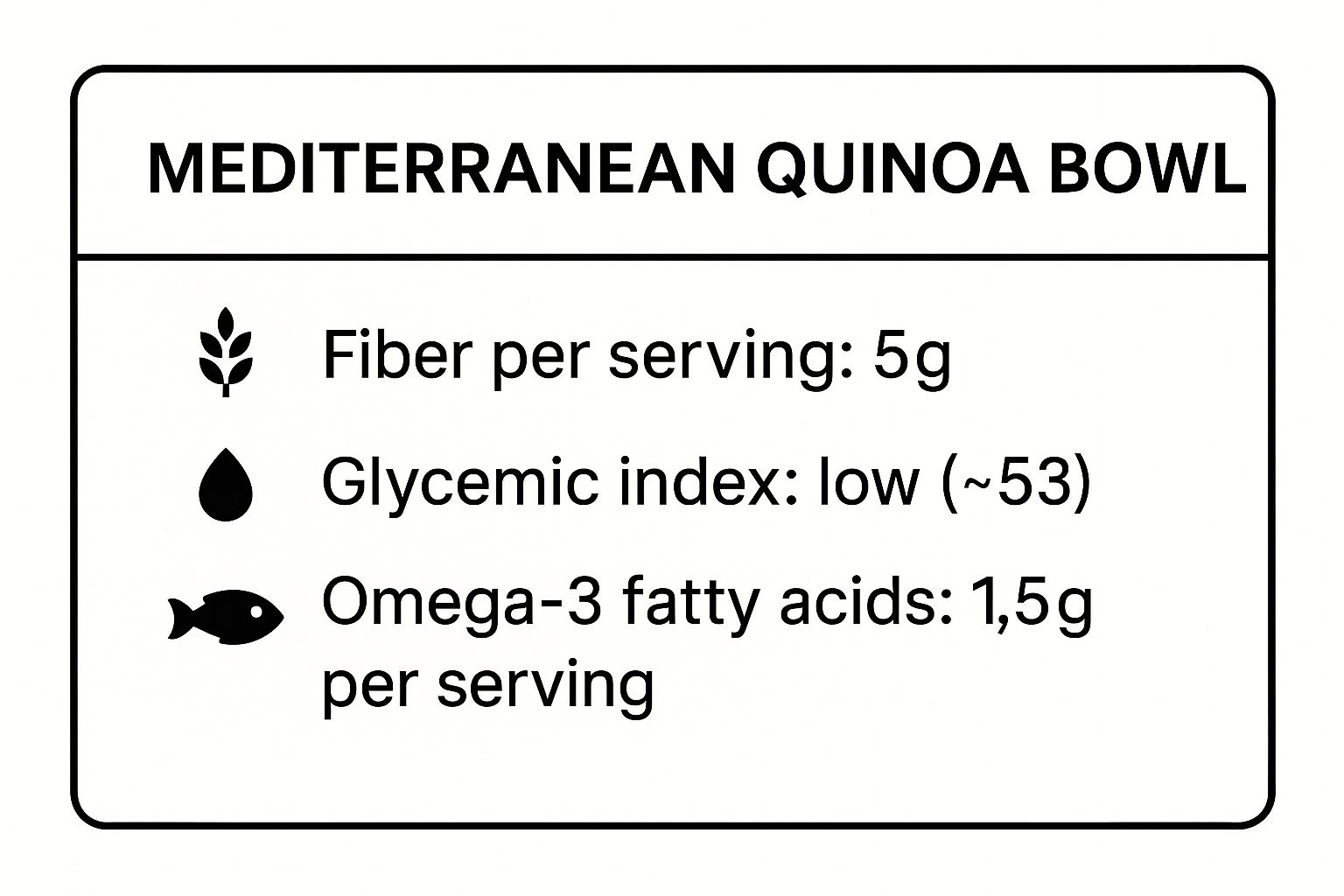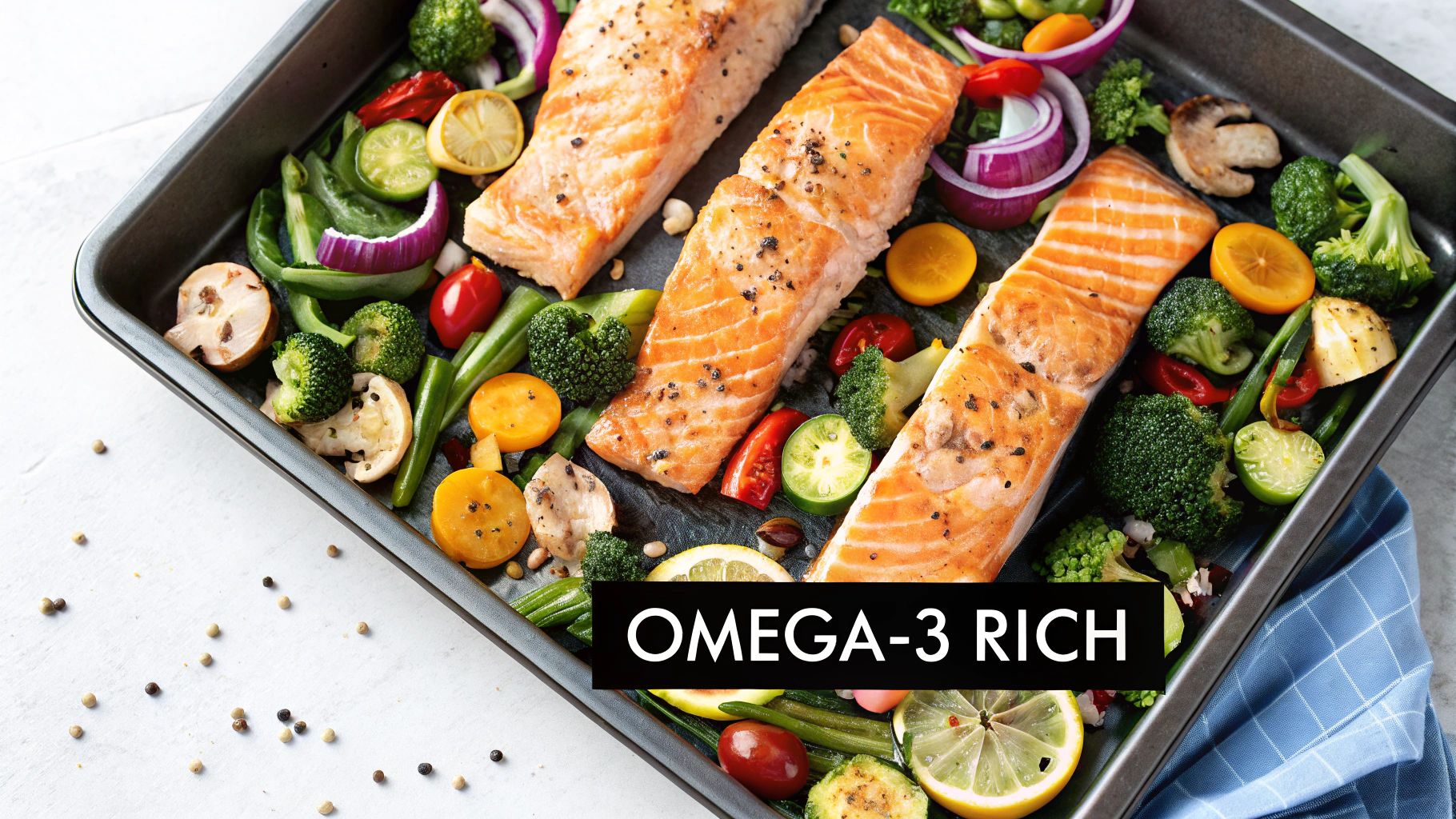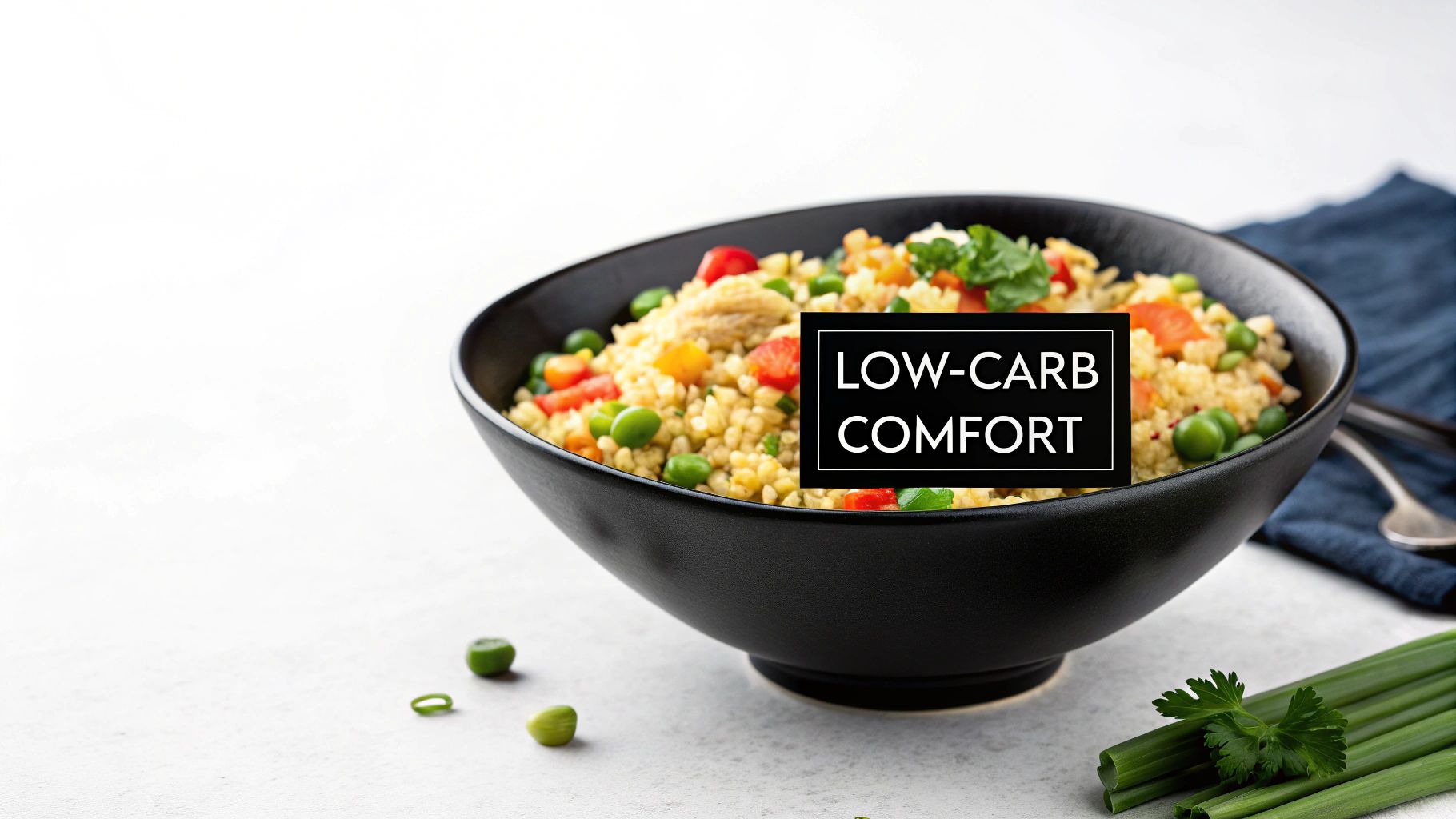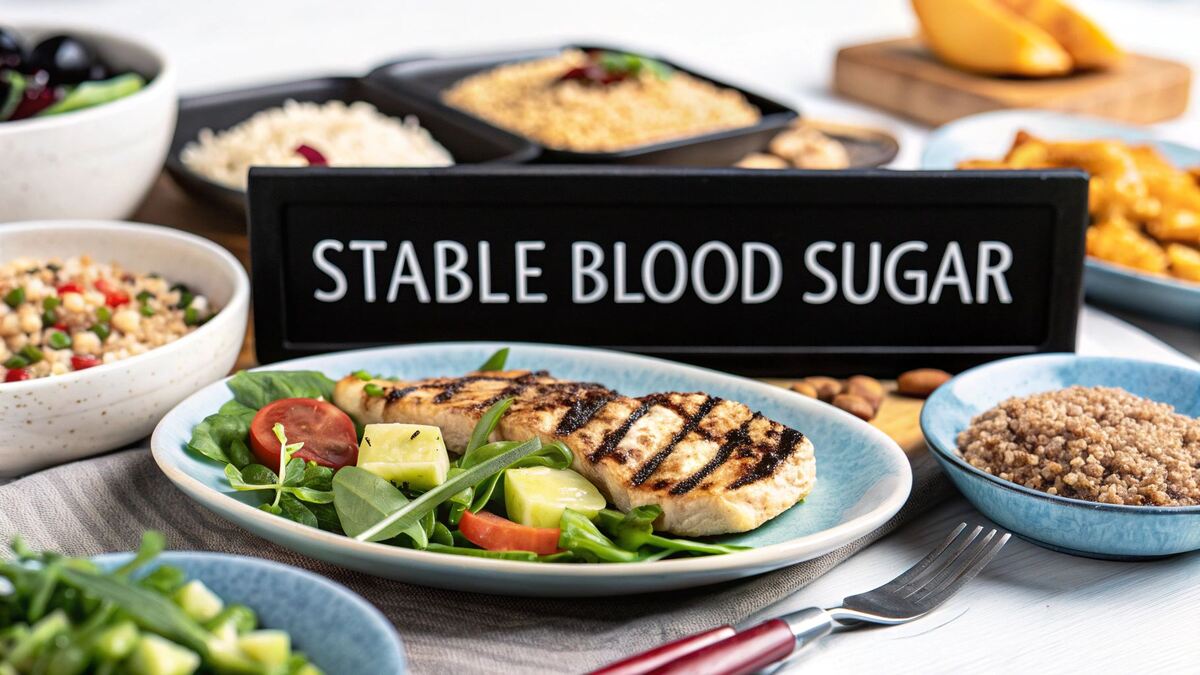8 Diabetic Friendly Meal Ideas for Stable Blood Sugar
Managing blood sugar doesn't have to mean sacrificing flavor, variety, or the joy of eating. Many people diagnosed with diabetes or prediabetes feel stuck in a food rut, cycling through the same bland, "safe" meals out of fear that anything more exciting will spike their glucose levels. This often leads to dietary boredom and makes long-term management feel like a chore rather than a sustainable lifestyle. The truth is, a world of vibrant, satisfying, and nutritionally balanced food is well within reach, and it's more accessible than you might think.
This guide is designed to break that cycle. We're moving beyond generic advice to provide specific, actionable, and delicious diabetic friendly meal ideas that are designed to keep you full, energized, and your blood sugar stable. We'll explore 8 distinct meal concepts that prove you can enjoy your food while taking excellent care of your health. Many of these meals are plant-forward, and for those exploring that path more deeply, a helpful resource on transitioning to a vegan diet can provide additional guidance. Each idea here is built on a foundation of protein, fiber, and healthy fats, ensuring you'll find meals you actually look forward to eating.
1. Mediterranean Quinoa Bowl
A Mediterranean Quinoa Bowl is an exceptional diabetic friendly meal idea that combines the robust, nutty flavor of quinoa with fresh vegetables, lean proteins, and heart-healthy fats. This approach to meal construction is ideal for blood sugar management because it prioritizes whole, unprocessed foods that are naturally low on the glycemic index. The base, quinoa, is a complete protein and a complex carbohydrate, meaning it digests slowly and helps prevent the rapid blood sugar spikes often associated with refined grains.
This meal is highly customizable, making it a sustainable choice for long-term health. The core components work together to provide a balanced nutritional profile: fiber from vegetables aids digestion and promotes satiety, lean protein helps maintain muscle mass and stabilize energy levels, and healthy fats from sources like olives and olive oil support cardiovascular health.
How to Build Your Bowl
Creating a balanced Mediterranean Quinoa Bowl is straightforward. Start with a foundation of cooked quinoa and then layer on your favorite ingredients. This method is perfect for meal prepping; you can prepare the individual components ahead of time and assemble your bowl in minutes for a quick and healthy lunch or dinner.
- Base: 1/2 to 1 cup of cooked quinoa. For added flavor, try cooking it in a low-sodium vegetable or chicken broth.
- Protein: Add 3-4 ounces of a lean protein source. Excellent choices include grilled chicken breast, baked salmon, chickpeas, or a sprinkle of feta cheese.
- Vegetables: Load up on non-starchy vegetables. Diced cucumber, cherry tomatoes, bell peppers, red onions, and Kalamata olives are classic additions.
- Healthy Fats & Dressing: Drizzle with extra virgin olive oil and a squeeze of fresh lemon juice. A dollop of Greek yogurt-based tzatziki sauce can also add creaminess and flavor.
This visualization provides a quick reference for the key nutritional metrics that make the Mediterranean Quinoa Bowl an excellent choice for a diabetic diet.

These metrics highlight the bowl's high fiber content, low glycemic impact, and heart-healthy fats, all of which are crucial for managing blood sugar and promoting overall well-being.
2. Zucchini Noodle Carbonara
Zucchini Noodle Carbonara offers a brilliant low-carb twist on the classic Italian pasta dish, making it an outstanding diabetic friendly meal idea. By swapping traditional high-carbohydrate pasta for spiralized zucchini, this recipe significantly reduces the glycemic load, helping to prevent sharp increases in blood sugar levels. This adaptation retains the rich, creamy, and savory flavors of carbonara, ensuring a satisfying meal without compromising on taste or texture.
This dish is perfect for anyone managing their carbohydrate intake while still craving comforting and flavorful food. The core ingredients provide a well-rounded nutritional profile: protein from the egg and bacon (or a leaner alternative) promotes satiety and stable energy, while the zucchini noodles offer vitamins, minerals, and a small amount of fiber. It’s a creative way to incorporate more non-starchy vegetables into your diet.
How to Build Your Bowl
Creating a delicious Zucchini Noodle Carbonara is quick and simple, making it a great option for a weeknight dinner. The key is to avoid overcooking the zucchini to maintain a pleasant, al dente texture.
- Base: 1 large zucchini, spiralized into noodles. To prevent a watery dish, salt the "zoodles" and let them drain in a colander for 10-15 minutes, then pat them dry.
- Protein: 2-3 slices of turkey bacon or pancetta, cooked until crisp and crumbled. For the sauce, whisk one whole pastured egg with 2-3 tablespoons of grated Parmesan cheese and black pepper.
- Vegetables: While the dish is zucchini-forward, you can add a handful of green peas for a pop of color, sweetness, and extra fiber.
- Assembly & Sauce: Briefly sauté the drained zucchini noodles for 1-2 minutes. Remove the pan from the heat and quickly stir in the egg and cheese mixture. The residual heat will cook the egg gently, creating a creamy, not scrambled, sauce.
This video provides a clear visual guide on how to prepare the dish, ensuring a perfect, creamy sauce every time.
By following this approach, you can enjoy a decadent-tasting meal that is fully aligned with a blood sugar-conscious eating plan.
3. Sheet Pan Salmon with Roasted Vegetables
A Sheet Pan Salmon with Roasted Vegetables meal is a superb diabetic friendly meal idea that offers incredible flavor and nutritional benefits with minimal cleanup. This one-pan approach simplifies dinner by combining a high-quality protein source, omega-3-rich salmon, with a medley of fiber-packed, non-starchy vegetables. Roasting everything together creates a delicious, cohesive meal that is naturally low in carbohydrates and high in essential nutrients, making it ideal for stable blood sugar management.

This meal is championed by organizations like the American Heart Association for its focus on heart-healthy fats, which are crucial for individuals managing diabetes. The combination of protein from the salmon and fiber from the vegetables promotes satiety, helping to prevent overeating and support weight management goals. Its simplicity also makes it a practical and sustainable option for busy weeknights.
How to Build Your Sheet Pan Meal
Creating this balanced meal is incredibly easy and highly adaptable to your personal taste and what's in your refrigerator. The key is to time the cooking of the vegetables and the fish correctly to ensure everything is perfectly cooked.
- Base: A colorful array of non-starchy vegetables. Great options include broccoli florets, asparagus spears, bell pepper strips, zucchini, and Brussels sprouts.
- Protein: A 4-6 ounce salmon fillet per person. You can also substitute other fatty fish like cod or trout for variety.
- Vegetables: Cut heartier vegetables like Brussels sprouts or carrots smaller so they cook at the same rate as the fish. Toss them with olive oil, salt, pepper, and herbs about 15-20 minutes before adding the fish to the pan.
- Healthy Fats & Seasoning: Use a light coating of extra virgin olive oil on both the fish and vegetables. Season simply with garlic powder, dried herbs like dill or oregano, and a squeeze of fresh lemon juice after cooking. Using parchment paper on your sheet pan makes cleanup effortless.
4. Cauliflower Fried Rice
Cauliflower Fried Rice is a brilliant diabetic friendly meal idea, offering the comforting flavors and texture of traditional fried rice with a fraction of the carbohydrates. This creative swap uses riced cauliflower instead of white rice, dramatically lowering the glycemic load and making it an excellent choice for blood sugar management. By using this non-starchy vegetable as a base, you can enjoy a satisfying, high-volume meal that supports stable glucose levels.
This dish is not only low in carbs but also rich in vitamins, minerals, and fiber, which helps promote fullness and aids in digestion. The versatility of cauliflower allows it to absorb the savory flavors of classic Asian seasonings, making it a delicious vehicle for lean proteins and a variety of colorful vegetables. It’s an ideal way to satisfy a craving for comfort food without compromising on your health goals.

How to Build Your Bowl
Creating your own Cauliflower Fried Rice is a quick, one-pan process perfect for a busy weeknight. The key is to cook the components over high heat to achieve a texture similar to traditional fried rice and avoid sogginess. You can customize it with your favorite proteins and vegetables to keep it interesting.
- Base: 1 to 2 cups of riced cauliflower. For the best texture, squeeze out any excess moisture from the riced cauliflower with a paper towel before cooking.
- Protein: Add 3-4 ounces of lean protein. Great options include diced chicken breast, shrimp, lean pork, or tofu. Scrambled eggs are a classic addition that also boosts protein content.
- Vegetables: Pack in the non-starchy vegetables. Diced carrots, peas, onions, bell peppers, and bean sprouts add flavor, crunch, and essential nutrients.
- Healthy Fats & Flavor: Sauté with a small amount of sesame oil or avocado oil. For flavor, use low-sodium soy sauce or coconut aminos, minced garlic, and fresh ginger. Garnish with chopped scallions.
This dish is a fantastic example of how simple substitutions can transform a high-carb meal into one of the best diabetic friendly meal ideas, providing both taste and nutritional benefits.
5. Turkey and Avocado Lettuce Wraps
Turkey and Avocado Lettuce Wraps are a fantastic diabetic friendly meal idea that swaps high-carb tortillas or bread for crisp, fresh lettuce. This simple exchange creates a light yet satisfying meal that is rich in lean protein, healthy fats, and fiber. This approach is excellent for blood sugar management because it drastically reduces the refined carbohydrate load, preventing the sharp glucose spikes that can occur after eating traditional sandwiches or wraps. The combination of ingredients provides a balanced nutritional profile perfect for a quick lunch or a light dinner.
This meal is incredibly versatile and allows for endless creativity while adhering to diabetic-friendly principles. The core components are chosen to support stable energy and prolonged fullness. Lean turkey provides high-quality protein to maintain muscle and manage hunger, while creamy avocado delivers heart-healthy monounsaturated fats and fiber. The lettuce itself adds a hydrating crunch and additional nutrients without impacting blood sugar levels.
How to Build Your Wraps
Assembling these wraps is simple, making them a go-to option for busy weekdays. The key is to have your ingredients prepped and ready for a quick build. You can prepare the filling ahead of time and store it separately from the lettuce leaves to maintain their crispness until you are ready to eat.
- Base: 2-3 large, sturdy lettuce leaves. Butter, iceberg, or romaine lettuce work best due to their natural cup shape and durability.
- Protein: Fill with 3-4 ounces of lean protein. Sliced deli turkey, shredded rotisserie chicken, or even a simple chicken salad made with Greek yogurt are excellent options.
- Vegetables: Add plenty of non-starchy vegetables for crunch and nutrients. Sliced tomato, cucumber, bell peppers, and shredded carrots are great additions.
- Healthy Fats & Toppings: Include slices of fresh avocado for creaminess and healthy fats. For extra texture and nutrients, consider adding a sprinkle of sunflower seeds or chopped almonds.
6. Lentil and Vegetable Soup
Lentil and Vegetable Soup is a powerhouse diabetic friendly meal idea, offering a comforting, hearty, and nutritionally dense option. This meal is particularly effective for blood sugar management because it combines high-fiber, plant-based protein from lentils with a variety of non-starchy vegetables. Lentils have a low glycemic index, which means they are digested slowly, leading to a gradual rise in blood glucose rather than a sharp spike.
This soup is incredibly versatile and serves as a complete, balanced meal in one bowl. The combination of protein and fiber promotes a strong sense of satiety, helping to prevent overeating and support weight management goals. Its rich nutrient profile, including iron, folate, and potassium, contributes to overall cardiovascular health, which is a key consideration in diabetes care.
How to Build Your Soup
Creating a flavorful and balanced Lentil and Vegetable Soup is simple. Begin with a flavorful base and layer in your lentils and vegetables. This soup is perfect for making in large batches for easy meal prep, providing a quick, warm, and satisfying meal throughout the week.
- Base: Start with a low-sodium vegetable or chicken broth. Sauté aromatic vegetables like onions, garlic, carrots, and celery to build a deep flavor foundation.
- Protein: Add 1 cup of rinsed dried lentils (green or brown hold their shape well, while red lentils create a creamier texture). This will provide the primary source of protein and fiber.
- Vegetables: Load up on non-starchy vegetables. Add chopped kale, spinach, zucchini, or bell peppers towards the end of the cooking time to retain their nutrients and texture.
- Flavor Boost: Use herbs like thyme, bay leaves, or cumin during cooking. Finish the soup with a squeeze of fresh lemon juice or a splash of vinegar to brighten the flavors and enhance the taste without adding salt.
7. Egg and Vegetable Frittata
An Egg and Vegetable Frittata is a fantastic diabetic friendly meal idea, offering a high-protein, low-carbohydrate option that is both satisfying and simple to prepare. This dish combines whipped eggs with a variety of non-starchy vegetables and cheese, baked until firm. Its minimal carbohydrate content means it has a very low impact on blood sugar levels, making it a safe and nutritious choice for any meal of the day, from breakfast to a light dinner.
The versatility of the frittata is a key benefit for maintaining a healthy eating plan. By loading it with fiber-rich vegetables like spinach, bell peppers, and mushrooms, you enhance its nutritional value and promote a feeling of fullness. The eggs provide high-quality protein and healthy fats, which are essential for stable energy and blood glucose control. This makes the frittata a powerful tool for managing diabetes without sacrificing flavor or satisfaction.
How to Build Your Frittata
Creating a delicious and balanced frittata is an easy process that works well for using up leftover vegetables. The key is to cook the vegetables first before adding the egg mixture and finishing it in the oven. This method is ideal for meal prepping; a single frittata can provide several portions for quick, healthy meals throughout the week.
- Base: 6-8 large eggs, whisked with a splash of milk or unsweetened almond milk, salt, and pepper.
- Protein: While eggs are the primary protein, you can enhance it with cooked lean sausage, diced ham, or a sprinkle of cheese like feta, goat cheese, or cheddar.
- Vegetables: Sauté your choice of non-starchy vegetables. Great options include chopped spinach, mushrooms, onions, bell peppers, broccoli, and asparagus.
- Cooking Method: Use a 10-inch cast iron or oven-safe skillet. Sauté the vegetables, then pour the egg mixture over them. Cook on the stovetop for a few minutes until the edges set, then transfer to a preheated oven (around 375°F or 190°C) to finish baking for 10-15 minutes.
8. Grilled Chicken with Greek Salad
Grilled Chicken with Greek Salad is a classic, refreshing meal that stands out as one of the most effective diabetic friendly meal ideas. This combination pairs lean protein with a vibrant mix of non-starchy vegetables, heart-healthy fats, and minimal carbohydrates. The star of the plate, grilled chicken, provides high-quality protein that helps stabilize blood sugar levels and promotes satiety, preventing overeating.
The accompanying Greek salad is rich in fiber, vitamins, and antioxidants from ingredients like cucumbers, tomatoes, and bell peppers. Healthy fats from Kalamata olives and extra virgin olive oil are crucial for cardiovascular health, a key consideration in diabetes management. This meal is naturally low-glycemic, ensuring a gradual release of energy without causing sharp spikes in glucose, making it a safe and delicious choice for any time of day.
How to Build Your Plate
Assembling this balanced meal is simple and perfect for a quick weeknight dinner or a pre-prepared lunch. The focus is on fresh ingredients and proper portioning to maximize nutritional benefits. Marinating the chicken beforehand not only adds incredible flavor but also helps tenderize the meat.
- Protein: Start with a 3-4 ounce portion of boneless, skinless chicken breast. Marinate it for at least 30 minutes in a mix of lemon juice, olive oil, oregano, and garlic before grilling or baking.
- Salad Base: Create a salad with chopped romaine lettuce, sliced cucumbers, cherry tomatoes, and thinly sliced red onion. Add a handful of Kalamata olives for a briny flavor and healthy fats.
- Dressing and Toppings: Crumble a small amount of feta cheese over the top. Create a simple, healthy dressing by whisking together three parts extra virgin olive oil with one part red wine vinegar or fresh lemon juice, seasoned with a pinch of dried oregano.
- Optional Boost: For added fiber and plant-based protein, consider mixing in a quarter-cup of chickpeas. To complete your meal and ensure a balanced plate, don't forget the importance of accompaniments; discover more ideas for delicious braai salads and healthy sides that pair perfectly.
Diabetic-Friendly Meal Options Comparison
| Dish | Implementation Complexity 🔄 | Resource Requirements ⚡ | Expected Outcomes 📊 | Ideal Use Cases 💡 | Key Advantages ⭐ |
|---|---|---|---|---|---|
| Mediterranean Quinoa Bowl | Moderate (requires quinoa cooking and prep) | Moderate (quinoa, fresh veggies, lean proteins) | Balanced nutrition; stable blood sugar | Meal prep; nutrient-dense meals | Complete protein; high fiber; customizable |
| Zucchini Noodle Carbonara | Low to Moderate (spiralizing skills needed) | Low (zucchini, eggs, cheese) | Very low glycemic impact; low carb | Quick low-carb meals | Fast prep; low calorie; gluten-free |
| Sheet Pan Salmon with Roasted Vegetables | Moderate (requires oven, timing) | Moderate to high (fresh salmon, veggies) | Very low glycemic impact; high omega-3 | Simple one-pan meals; heart health | Minimal cleanup; high protein; visually appealing |
| Cauliflower Fried Rice | Moderate (need to rice cauliflower) | Low to moderate (cauliflower, proteins, veggies) | Low glycemic impact; satisfies rice craving | Low-carb comfort food replacement | Versatile proteins; quick cooking; high fiber |
| Turkey and Avocado Lettuce Wraps | Low (assembly only) | Low (turkey, avocado, lettuce) | Very low glycemic impact; high satiety | Portable, quick meals | High healthy fats; refreshing; quick assembly |
| Lentil and Vegetable Soup | Moderate to High (longer cooking time) | Low (lentils, vegetables, broth) | Low to moderate glycemic impact; filling | Budget-friendly; meal prep; plant-based | High fiber & protein; cost-effective; freezer-friendly |
| Egg and Vegetable Frittata | Moderate (oven needed; pan skills) | Low (eggs, vegetables) | Very low glycemic impact; stable blood sugar | Breakfast, brunch, any meal | Complete protein; one-pan; customizable |
| Grilled Chicken with Greek Salad | Moderate (grilling and marinating) | Moderate (chicken, fresh veggies, feta, olive oil) | Very low glycemic impact; satiating | Mediterranean-inspired lean meals | Anti-inflammatory; simple prep; antioxidant rich |
Making Diabetic-Friendly Eating a Delicious Reality
Navigating the world of diabetic-friendly eating is not about restriction; it's a powerful journey toward culinary discovery and proactive health management. Throughout this guide, we've explored a variety of vibrant, satisfying, and blood sugar-conscious meal ideas, from the hearty Lentil and Vegetable Soup to the fresh and zesty Grilled Chicken with Greek Salad. Each recipe underscores a fundamental principle: managing diabetes through diet doesn't require sacrificing flavor or enjoyment.
The meals highlighted, including the Sheet Pan Salmon with Roasted Vegetables and the innovative Zucchini Noodle Carbonara, demonstrate that a balanced plate is both achievable and delicious. By prioritizing lean proteins, fiber-rich vegetables, healthy fats, and controlled portions of complex carbohydrates, you create a powerful framework for stable blood sugar levels and sustained energy throughout the day.
Key Takeaways for Sustainable Success
Adopting these diabetic friendly meal ideas is about building sustainable habits, not just following a rigid diet. Remember these core principles as you move forward:
- Prioritize Whole Foods: Center your meals around unprocessed ingredients. Think colorful vegetables, lean protein sources like chicken and fish, and fiber-packed legumes and whole grains like quinoa.
- Embrace Healthy Fats: Incorporate sources like avocado, nuts, seeds, and olive oil. These fats are crucial for satiety and play a vital role in heart health, a key consideration in diabetes management.
- Master Portion Control: Even the healthiest foods can impact blood sugar if eaten in excess. Using smaller plates, measuring servings, and listening to your body's hunger cues are essential skills.
- Plan for Consistency: Success is built on routine. Dedicate a small amount of time each week to plan your meals, shop for ingredients, and prep components in advance. This removes the stress of last-minute decisions and makes healthy choices the easy choices.
Actionable Next Steps to Get Started
Feeling inspired is one thing; taking action is what creates change. Here’s how you can seamlessly integrate these concepts into your life starting today:
- Select Two Recipes: Don't try to overhaul your entire diet overnight. Choose just two meals from this list that appeal to you, perhaps the Turkey and Avocado Lettuce Wraps for a quick lunch and the Egg and Vegetable Frittata for a weekend breakfast.
- Create a Shopping List: Based on your chosen recipes, make a detailed grocery list. Sticking to a list helps you avoid impulse buys and ensures you have everything you need.
- Schedule Your Cooking Time: Block out time in your calendar for meal prep. Even 30 minutes of chopping vegetables or cooking a batch of quinoa can make a huge difference during a busy week.
By transforming these diabetic friendly meal ideas from concepts into regular features on your menu, you are taking a significant, empowering step toward managing your health. This approach fosters a positive relationship with food, turning mealtimes into an opportunity to nourish your body and delight your palate. You are not just managing a condition; you are investing in your long-term vitality and well-being, one delicious, balanced meal at a time.
Ready to take the guesswork out of meal planning and discover endless diabetic friendly meal ideas tailored just for you? The AI Meal Planner creates personalized weekly menus based on your specific dietary needs, providing recipes, grocery lists, and nutritional guidance to make healthy eating effortless. Start building your custom plan today at AI Meal Planner.
AI-powered nutrition
Get Your Personalized Meal Plan
AI creates the perfect meals for your goals, lifestyle, and taste.
Start Your Journej
